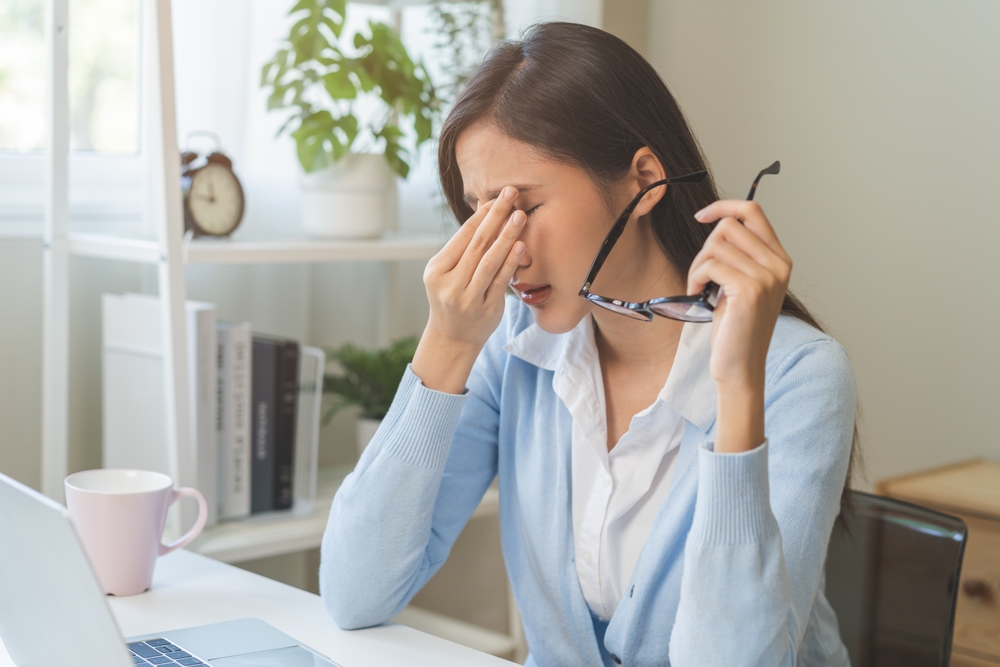What are the Most Common Symptoms of Dry Eye?
November 5, 2024
If your eyes itch, burn, or are noticeably red after working on a computer, or if you often feel like you have something stuck in your eye that you can't get out, you may be experiencing dry eye. Keep reading to learn more about the most common symptoms of dry eye!
What is Dry Eye?
Dry eye affects millions of people in the US. It occurs when the eyes do not produce enough tears or only low-quality tears that are unable to keep the eye adequately moist.
Identifying and understanding the most common symptoms of dry eye is essential to finding relief.
Symptoms of Dry Eye
Dry eye can present many common symptoms. However, some of the most common are:
Dryness
The most obvious symptom of dry eye is a sensation of dryness in the eye. This dry sensation happens when the eyes are not adequately lubricated, leading to discomfort.
Dry eye can occur when the tear film that keeps the eyes moist is insufficient or evaporates too quickly. Without a proper tear film, the surface of the eyes can become dry and irritated.
Itching
Itchy eyes are another common symptom of dry eye. This symptom is often accompanied by the urge to rub the eyes, which can make the itchiness worse.
When eyes are dry, the lack of adequate lubrication can lead to inflammation, which can cause the eyes to feel itchy. Rubbing itchy eyes can further irritate the eyes and worsen dryness.
Burning
A burning or stinging sensation is a frequently reported symptom of dry eye. It can feel as though something hot is irritating the surface of the eye.
Without enough tear film, the sensitive tissue on the surface of the eye is exposed to the air, leading to irritation and inflammation. This symptom of dry eye can be worse when the eyes are exposed to wind, smoke, or air conditioning.
Redness
Red or bloodshot eyes are a very noticeable symptom of dry eye. The whites of the eye may appear more red than usual, indicating inflammation or irritation.
A lack of moisture on the eye's surface can irritate or inflame the conjunctiva, the thin membrane covering the white part of the eye. As a result, the blood vessels in the conjunctiva become more prominent, causing the eyes to appear red.
Grittiness
 People with dry eyes often describe a gritty or sandy feeling, as if tiny particles of sand were trapped beneath their eyelids.
People with dry eyes often describe a gritty or sandy feeling, as if tiny particles of sand were trapped beneath their eyelids.
The lack of sufficient tear film causes the eyes to lose their smooth surface. Without enough tear film to keep them lubricated, the surface of the eyes can feel rough, leading to a gritty sensation.
Excessive Tearing
While it may seem strange, excessive tearing or watery eyes can be another symptom of dry eyes. This occurs when the eyes suddenly produce too many tears in response to irritation.
Tearing is the body's natural response to dryness. However, these tears usually lack the necessary components to effectively lubricate the eyes, leading to continued dryness once the excess tears evaporate.
Blurry Vision
Blurry vision can be a common symptom of dry eye. It can temporarily impair visual clarity, which usually becomes clearer after blinking or using artificial tears.
Tear film is essential to maintaining a smooth and even surface on the cornea, which is necessary for clear vision. When the eye is dry, or tears evaporate too quickly, it can create corneal irregularities, leading to blurred vision.
Eye Fatigue
Eye fatigue is also a common symptom of dry eye. A person with dry eye may find it harder to keep their eyes open, particularly while engaged in activities that require sustained visual attention, like reading or using a computer.
In dry eyes, the lack of moisture and lubrication can make focusing more difficult, causing eyes to become strained and tired more quickly. This is especially true when blinking is reduced, often during extended periods of viewing an electronic screen.
Pain or Soreness
 Some people with dry eyes experience varying degrees of eye pain and soreness. The pain can range from mild discomfort to more severe, sharp sensations.
Some people with dry eyes experience varying degrees of eye pain and soreness. The pain can range from mild discomfort to more severe, sharp sensations.
Chronic dryness and inflammation of the surface of the eye can be extremely painful, particularly if the untreated, dry eye has caused corneal damage. In severe cases, untreated dry eye can lead to corneal abrasions or ulcers.
Discharge
Dry eye can cause the eyes to create a sticky mucus discharge, which can accumulate in the corners of the eyes or along the eyelids. When dry eye causes inflammation on the surface of the eye, it stimulates mucus production.
Tears normally contain a small amount of mucus, but low-quality tears can contain excess mucus that creates discharge.
Sensitivity to Light (Photophobia)
Many people with dry eye experience increased sensitivity to light, a condition known as photophobia. Exposure to bright lights, whether natural sunlight or artificial indoor lighting, may cause eye discomfort or pain.
When the eyes are dry, the cornea can become more exposed and irritated, increasing the eye's sensitivity to light. Inflammation caused by dry eye can also lead to photophobia.
If you are experiencing any of the dry eye symptoms listed above, it's best to schedule a comprehensive eye exam with your eye doctor to get a proper diagnosis and learn about your treatment options. Effective treatment options, like artificial tears, medicated eye drops, and procedures like the advanced iLight to improve tear production, can help relieve the common symptoms of dry eye.
Are you experiencing symptoms of dry eye? Schedule an appointment at Arlington Eye Center in Arlington, VA, today!



